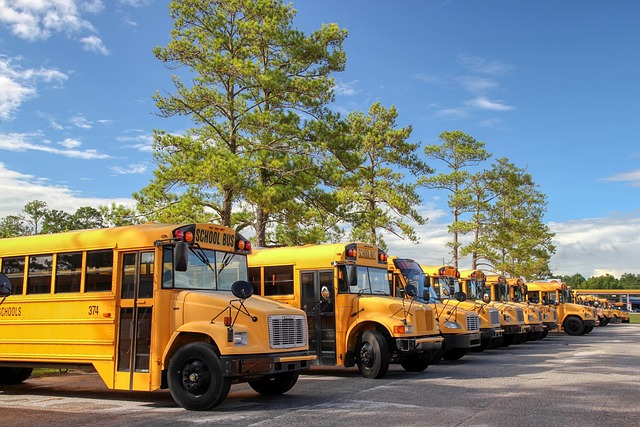Advanced Braking Systems (ABS) transform bus safety in urban areas with smart stations and eco-tourism services, optimizing fuel efficiency and reducing brake wear. Airbags, seatbelts, emergency exits, and advanced lighting are crucial safety features in select buses, especially for budget travel and ecotourism. GPS tracking enhances safety and operational efficiency by real-time fleet monitoring, route adherence, and fuel consumption tracking. Accessible buses with ramp access, low-floor entrances, and dedicated spaces cater to diverse needs, promoting equal participation in public transport options like bus tours.
“Discover the advanced safety features that make modern select buses a cut above. From sophisticated Advanced Braking Systems that prevent accidents to life-saving airbags and seatbelts, these vehicles prioritize passenger protection. Efficient emergency exits and strategic lighting facilitate quick evacuations in unforeseen events. GPS Tracking enhances safety monitoring, while accessibility features ensure every rider is accommodated. Explore these transformative safety measures designed to enhance travel peace of mind.”
- Advanced Braking Systems: Preventing Accidents
- Airbags and Seatbelts: Protecting Passengers
- Emergency Exits and Lighting: Quick Evacuation
- GPS Tracking: Enhancing Safety Monitoring
- Accessibility Features: Accommodating All Riders
Advanced Braking Systems: Preventing Accidents

Advanced Braking Systems play a pivotal role in enhancing bus safety and preventing accidents. These cutting-edge technologies are designed to ensure that select buses can swiftly and accurately respond to sudden stops, allowing for better control and minimizing the risk of collisions. By employing sophisticated sensors and algorithms, these systems can detect obstacles as well as the speed and movement of other vehicles around them, enabling drivers to take immediate corrective actions. This proactive approach significantly contributes to the overall safety of passengers and other road users, especially in densely populated urban areas where smart bus stations and eco-tourism transport services thrive.
Moreover, advanced braking systems offer benefits beyond accident prevention by optimizing fuel efficiency and reducing wear on brakes. In today’s competitive market, where bus auction houses facilitate the sale and purchase of vehicles, these safety features are increasingly sought after by both buyers and operators. By prioritizing safety, select buses equipped with such systems not only attract more passengers but also contribute to a greener environment through reduced emissions, aligning perfectly with the growing demand for sustainable transport solutions including eco-tourism bus catering services.
Airbags and Seatbelts: Protecting Passengers

Airbags and seatbelts are essential safety features found in modern buses, designed to protect passengers during unexpected events on the road. These advanced systems play a pivotal role in minimizing the risk of injuries by providing immediate protection upon collision. Airbags, when deployed, offer a soft cushion that helps to absorb the impact, while seatbelts tighten around the passenger, securing them in place and preventing sudden movements that could cause harm.
When selecting buses, especially for budget-friendly travel or bus travel tips catering to special dietary options and comfy seating arrangements, it’s crucial to ensure these safety mechanisms are up to date and functioning optimally. Such considerations not only contribute to a safer journey but also enhance the overall passenger experience, ensuring that everyone aboard arrives at their destination securely and comfortably.
Emergency Exits and Lighting: Quick Evacuation

Emergency exits and lighting are critical safety features in select buses designed for quick evacuation in case of emergencies. These buses prioritize passenger safety by strategically placing easily accessible emergency exits, often equipped with glow-in-the-dark markings, to enable swift and orderly departures. Advanced lighting systems further enhance visibility during nocturnal incidents or power outages, ensuring passengers can navigate the bus efficiently even under challenging conditions.
Reclining seats in eco-friendly buses not only provide comfort but also contribute to safer evacuations by offering clear aisles for passage. Moreover, modern second-hand coach purchases often incorporate updated safety features, making them viable options for ecotourism transport and bus catering services while prioritizing passenger well-being.
GPS Tracking: Enhancing Safety Monitoring

GPS tracking has emerged as a powerful tool for enhancing safety monitoring in the transportation industry, and its impact is particularly significant when applied to select buses. This technology allows bus tour operators to keep a close eye on their fleet’s location and movement in real-time. By integrating GPS into their operations, companies can ensure that drivers adhere to scheduled routes and speed limits, reducing the risk of accidents. Moreover, it facilitates efficient fleet management by providing insights into fuel consumption, driver behavior, and vehicle maintenance needs.
The benefits extend beyond operational efficiency. GPS tracking plays a crucial role in ensuring the safety of animal transport regulations, as it enables quick response times to unexpected events or detours. Additionally, digital bus information displays powered by GPS can keep passengers informed about their trip status, including delays or changes, enhancing overall passenger satisfaction. This technology not only contributes to road safety but also streamlines the processes for select buses operating in today’s bustling urban environments.
Accessibility Features: Accommodating All Riders

Selecting buses with built-in accessibility features is crucial when it comes to accommodating all riders, regardless of their physical abilities. Modern public transport options often include ramp access, low-floor entrances, and dedicated spaces for wheelchairs or mobility scooters, ensuring ease of boarding and safe travel for everyone. These features are especially beneficial for those who rely on group bus bookings for excursions, like scenic bus routes to the mountains, where accessibility needs might vary.
Furthermore, considerate design extends to other aspects such as tactile floor markings, braille signage, and audible announcements, which aid visually impaired passengers. By incorporating these accessibility measures, select buses offer a more inclusive experience, promoting equal opportunities for participation in various public transport options, including bus tours.
When considering bus safety features, it’s clear that modern transportation prioritizes passenger protection. From advanced braking systems and robust airbags to accessible designs, select buses are equipped with comprehensive safety measures. GPS tracking further enhances monitoring capabilities, enabling swift response times during emergencies. These integrated features contribute to a safer riding experience for all, making buses a reliable and secure mode of travel.
